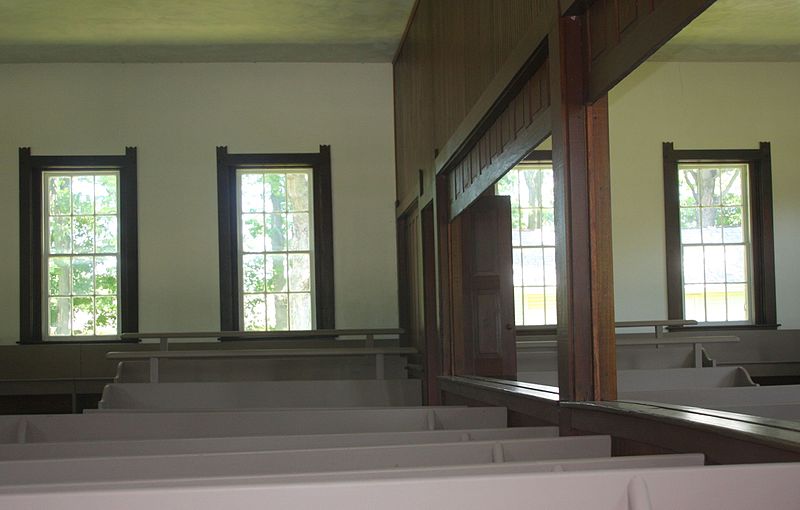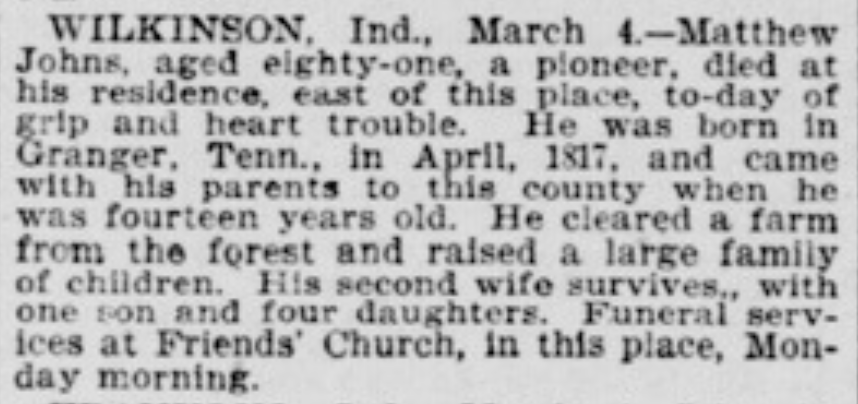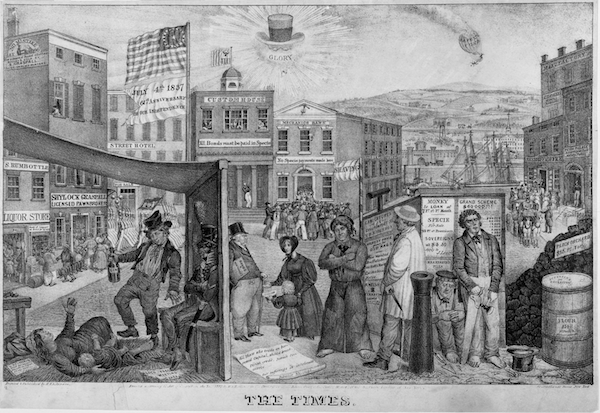Tuesday’s Tip: Researching Matthew Johns and his Second Wife

Murrell Family, Roberts Family (Click for Family Tree)
Tuesday’s Tip: Research organizations to which your ancestor belonged, whether religious, fraternal, military veteran, club, or ?? They may provide answers to questions that will help flesh out your family history.
Finding out that the funeral service of Matthew Johns took place at the Friends Church in Wilkinson, Indiana, was quite a surprise- we had no idea he belonged to the Religious Society of Friends, also known as Quakers. The fact that he had a second wife was a surprise as well. We do have other Quaker ancestors, such as Lewis Walker of Chester, Pennsylvania, so learning a bit more about Quakerism seemed in order, and might help us to learn more details about this family’s life.
One of our research goals is to learn the name of Matthew’s second wife, and another is to learn the date of their marriage. We started with the hypothesis that the date was after Matthew’s first wife, Ellen (Maggard) Johns passed away in 1886. A search in Indiana marriage records, however, came up empty.
Our additional research into the Quakers in Indiana gave a clue as to a possible reason for us being unable to find a marriage record. The Indiana Historical Society has a wonderful website that includes an “Introduction to the Quaker Records Project.” This document should be required reading for anyone researching Quakers.
The Intro explains that Quakers (AKA “Friends”) did not believe in being married by a “hireling priest” or a civil servant- Friends married themselves. They also monitored themselves to ensure proper behavior. One of the Quaker church gatherings was called a “Monthly Meeting” (MM), and at that meeting, the couple would announce their intention to marry- similar to the marriage banns required by the Catholic church and other religions. After the intention was announced, the MM would appoint a committee to investigate and make sure the bride and groom were both “clear of engagements,” i.e., not married or promised to another. If the individuals were, indeed, free of others per the committee’s report at the next MM, the couple would be declared “at liberty to accomplish the marriage.” Of course, a committee would be appointed to attend the marriage to ensure that “good order was preserved.” Sometimes a special meeting was called to include the marriage, and in earliest Quaker marriages, the ceremony would take place at the next midweek worship meeting. After the mid-1800s, which was when Matthew would have married a second time, the marriage took place on First-day. (First-day was Sunday, and meetings occurred on this day. The Quakers used a “plain calendar” which used numbers for days of the week and the months- they did not want to use names derived from pagan deities, like Saturday, named after Saturn, an ancient Roman god of time, agriculture, plenty, or January, named after the Roman god Janus, the god of beginnings and endings, passages and duality, etc.)
Detailed records were kept of the business of the Monthly Meeting, so if they survive for the Wilkinson Church, we should be able to learn the name of Matthew’s second wife, when they married, and even her parent’s names and residences of all involved.
Understanding the process of marriage within a religion is always insightful, but why does this have importance in our research? The Indiana History website tells us:
“The laws of Indiana, until the 1920s, exempted Friends from the legal requirement to obtain a civil marriage license. Thus marriages performed under the care of a monthly meeting will not be found in courthouse records.”
Looking at the historical timeline of an organization and their rules/dogma may give us more clues to help our research:
“Disownment for marrying a non-Friend or for marrying by civil ceremony had been abandoned by the 1860s. The member concerned had only to indicate that he wished to retain his membership. By the 1880s the whole matter was ignored. Some Friends churches had paid preachers, and the marriage form was soon fashioned after other Protestant ceremonies.”
So yes, we will still look further for this marriage information within civil records, since they likely married in the mid-1880s. But we now know that we may only find the information within the records of a Monthly Meeting, especially if this more-rural church maintained a more traditional point of view.
Knowing this information, we have another clue into Matthew’s life: his second wife may have been Quaker, since we have not yet found a marriage record, but his first wife may not have been when they married, since we do have a record of their marriage. Of course, this is hypothesis, and more research into the Quaker records of this area may give us the answers we desire.
Notes, Sources, and References:
- Introduction to the Quaker Records Project– http://www.indianahistory.org/our-services/books-publications/magazines/online-connections/quaker-records/introquakerrecords.pdf
- Image from Wikipedia, https://commons.wikimedia.org/wiki/File:SugarGroveFriendsDivision.jpg
- GFDL 1.2 for image– https://commons.wikimedia.org/wiki/Commons:GNU_Free_Documentation_License,_version_1.2
- FamilySearch Wiki articles on Quakers– https://www.familysearch.org/wiki/en/Society_of_Friends_(Quakers)_in_the_United_States and https://www.familysearch.org/wiki/en/U.S._Quaker_Research_(Society_of_Friends)
- Wilkinson Meetings are listed under the Knightstown meeting (formerly Raysville), located in Henry County, Indiana– https://quakermeetings.com/Plone/meeting_view?anID=514 and the Shirley meeting, located in Hancock County, Indiana– https://quakermeetings.com/Plone/meeting_view?anID=815. Unfortunately none of the links worked for websites with the records.
Click to enlarge any image. Please contact us if you would like an image in higher resolution.
We would love to read your thoughts and comments about this post (see form below), and thank you for your time! All comments are moderated, however, due to the high intelligence and persistence of spammers/hackers who really should be putting their smarts to use for the public good instead of spamming our little blog.Original content copyright 2013-2017 by Heritage Ramblings Blog and pmm.
Family history is meant to be shared, but the original content of this site may NOT be used for any commercial purposes unless explicit written permission is received from both the blog owner and author. Blogs or websites with ads and/or any income-generating components are included under “commercial purposes,” as are the large genealogy database websites. Sites that republish original HeritageRamblings.net content as their own are in violation of copyright as well, and use of full content is not permitted. Descendants and researchers MAY download images and posts to share with their families, and use the information on their family trees or in family history books with a small number of reprints. Please make sure to credit and cite the information properly. Please contact us if you have any questions about copyright or use of our blog material.SaveSave
SaveSave
SaveSaveSaveSave
SaveSave
SaveSave




